
|
Eran and Vidisha, famous sites of great antiquity, were among the dominating urban
centers of eastern Malwa in post-Mauryan Central India. Eran is situated on the south bank of the
Bina river, a tributary of river Betwa, and Vidisha is on the east bank of the Betwa,
approximately 50 miles away. Other major urban centers of
eastern Malwa were Bhagila, Kurara and Nandinagara (Nadner). An early trade route connecting
Pataliputra with Mathura passed through Eran-Vidisha lands. And while one trade
route went from Kausambi in the Allahabad district to the eastern sea
coast, another route connected Kausambi in a south-westerly direction with
Bharhut, Eran, Vidisha, Ujjain, Mahismati and finally Broach on the
western sea coast.
In contrast to the more or less exclusive use of die-struck local coins
in western Malwa, dominated by the urban center of Ujjain, some local
powers of eastern Malwa used die-struck coins, while others issued punchmarked copper
coins during this post-Mauryan period. Traditionally, these coins have been assigned to
"Eran" but they may have been issued in Vidisha or other neighbouring centers as well.
The Eran-Vidisha region is the source of an important series of
attractive,well executed ancient punchmarked copper coins. These local
coins of eastern Malwa developed in the post-Mauryan time when the
political control of the region had fallen to local dynasts. The very
distinctive local coinages, such as that of Eran and Vidisha in eastern Malwa
or that of Ujjain in
western Malwa, are an indication that these regions were
practically independent when issuing these coins. One cannot
fix the start of the local Eran-Vidisha punchmarked
coppers precisely but the second part of the 2nd century BC is
probable. The series came to an end when the Satavahanas
incorporated Malwa into their growing empire around the middle of the
1st century BC. A few Eran punchmarked coins with Satavahana
inscriptions confirm the dynastic change in this region.
Usually there are 4-5 different punches on an Eran coin. The maximum
amount of punches is six and a few types have only two or three
punches. The reverse of most specimens is blank but sometimes we see
the remains of an old undertype. The commonest devices on Eran coins
are elephant, horse, so-called Ujjain symbol, river, railed standard,
railed tree and (lotus-)flower with eight petals. Sometimes we see also
a bull, a six-armed symbol, a taurine fixed in an open railing, a
damaru in a damaru-shaped enclosure or a standard in a damaru-shaped
enclosure. Depictions of a lion or a human being are rarely found. The
taurine fixed in an open railing is a very characteristic symbol of the
Eran-Vidisha region but sometimes it is also found on types from
Vidarbha. A symbol which appears to be specific for the
Eran series occurs in two modifications: as a closed semicircle with
two fish inside and as a
semicircle with two crosses inside
Concerning metrology it is not always possible to attribute the coins
of this series to clearly defined different denominations.
Theoretically a copper karshapana would weigh 9.33g and its subunits
accordingly. In reality we see a continuum of weights indicating that
such coppers were not valued according to their
intrinsic value with the same accuracy as it was the case with gold and silver coins.
This is an observation that holds true for many copper coinages of
ancient India which were at least to a certain extent traded at
token value.
|
 |
Human Types
|
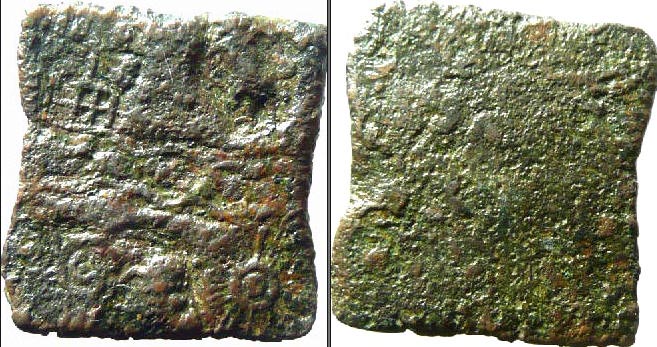
|
Eran, anonymous 1/2 AE karshapana, six punch 'human type'
Weight: 4.85 gm., Dimensions: 20x19 mm.
River in centre; on top railed tree on left and standing human on right; on the
bottom from left to right 'Ujjain symbol', bull and sun.
Blank reverse
Reference: Pieper 458 (plate coin)
|
 |
The human figure holds a stick and a water-pot (kamandalu); though these attributes
are not specific they might nevertheless indicate that this is a depiction of Siva.
|
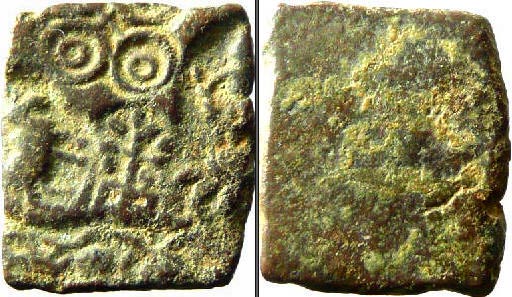
|
Eran, anonymous 1/2 AE karshapana, five punch 'human type'
Weight: 3.99 gm., Dimensions: 18x16 mm.
Bull on the left, railed tree in centre, standing human on right; river at the bottom;
'Ujjain symbol' at the top.
Blank reverse
Reference: Pieper 459 (plate coin)
|

|
Eran, anonymous 1/2 AE karshapana, large 'human type' countermark
Weight: 4.73 gm., Dimensions: 21x20 mm.
A large c/m depicting a standing human holding stick and kamandalu is placed on the blank
reverse of a worn Eran coin which shows an 'Ujjain symbol' and a lotus-flower.
Reference: Pieper 420 (plate coin)
|
 |
Such countermarks with a Siva-like depiction appear on different types of Malwa coppers
but more frequently on types from the Ujjain region than on those from the Eran-Vidisa region.
|
 |
 |
 |
Animal Types
|
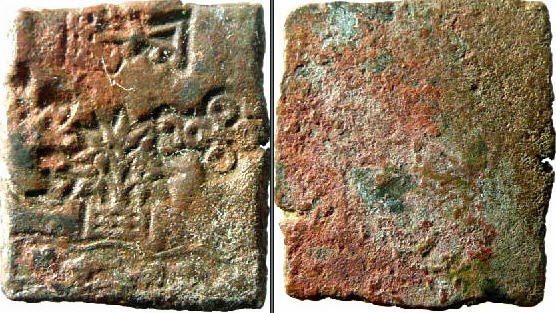
|
Eran, anonymous 1/4 AE karshapana, five punch 'elephant type'
Weight: 2.80 gm., Dimensions: 19x16 mm.
Elephant on the left, railed tree in centre,'Ujjain symbol' with nandipada on one of its
orbs on right; railed Indradhvaja on top; river at the bottom.
Blank reverse
Reference: Pieper 460 (plate coin)
|
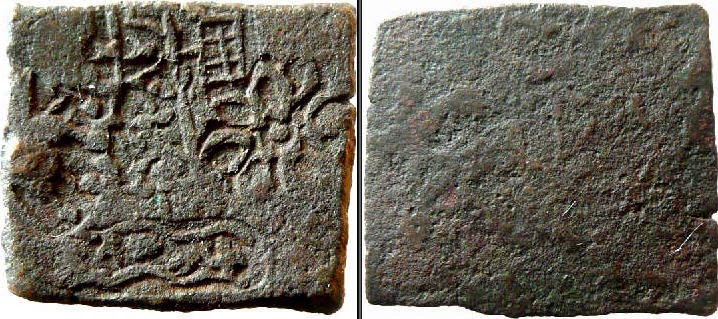
|
Eran, anonymous 1/2 AE karshapana, five punch 'elephant type'
Weight: 5.52 gm., Dimensions: 20x18 mm.
Elephant on the left, railed tree in centre, (lotus)flower on the right;
railed Indradhvaja on top; river at the bottom.
Blank reverse
Reference: Pieper 463 (plate coin)
|
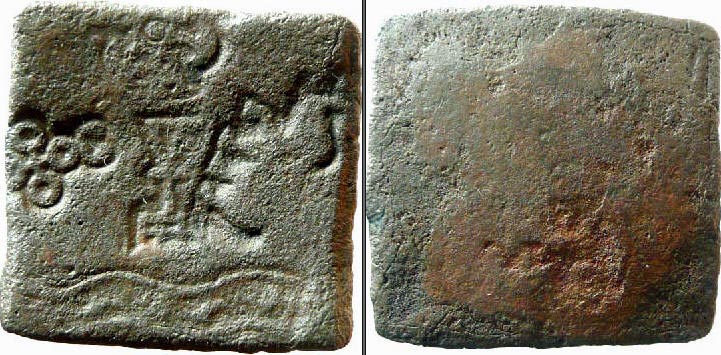
|
Eran, anonymous 3/4 AE karshapana, five punch 'elephant type'
Weight: 6.24 gm., Dimensions: 20x20 mm.
Elephant on the right, railed Indradhvaja in centre, 'Ujjain symbol' with nandipada on
one of its orbs on the left; river at the bottom.
Blank reverse
Reference: Pieper 464 (plate coin)
|

|
Eran, anonymous AE karshapana, five punch 'elephant type'
Weight: 7.84 gm., Dimensions: 21x21 mm.
Elephant on the right, railed Indradhvaja in centre, taurine in open enclosure on left;
six-armed symbol, on top; river at the bottom.
Blank reverse
Reference: BMC, pl.XVIII, no.9 / Pieper 465 (plate coin)
|

|
Eran, anonymous 3/4 AE karshapana, five punch 'horse type'
Weight: 6.94 gm., Dimensions: 25x23 mm.
Obv.: Horse on the left and six-armed symbol on the right.
Rev.: 'Ujjain symbol' and Indradhvaja on top; river at the bottom.
Reference: Pieper 468 (plate coin)
|
 |
Note the distribution of the five punches to obverse and reverse; this is something very unusual for the coins
of the whole series.
|
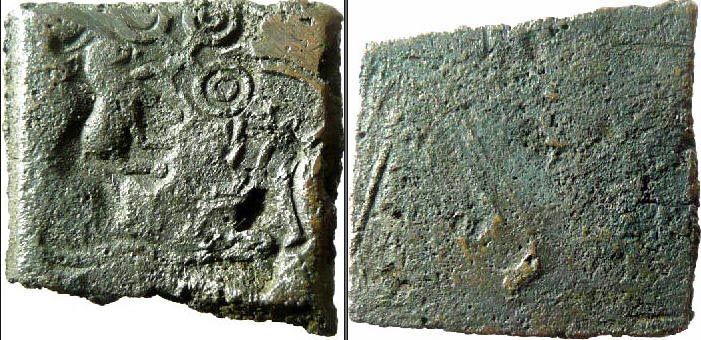
|
Eran, anonymous AE karshapana, four punch 'horse type'
Weight: 8.03 gm., Dimensions: 20x17 mm.
Horse on the left, Indradhvaja in damaru-shaped enclosure on the right;
'Ujjain symbol' on top; river at the bottom.
Blank reverse
Reference: Pieper 466 (plate coin)
|

|
Eran, anonymous AE karshapana, four punch 'horse type'
Weight: 10.83 gm., Dimensions: 25x23 mm.
Obv.: Horse on the right and tree-on-hill with a taurine in each of its three archs on the left;
'Ujjain symbol' with taurine topped lines between; river at the bottom
Reference: S. Tiwari collection, p.144, type24, var.c / Pankaj Tandon collection
|

|
Eran, anonymous AE karshapana, five punch 'horse type'
Weight: 10.25 gm., Dimensions: 23x22 mm.
Horse on the left, railed tree in centre,elaborate Ujjain symbol on the right, railed
Indradhvaja on top, river at the bottom.
Blank reverse
Reference: BMC, pl. XVIII, no.14/ Pieper 467 (plate coin)
|

|
Eran, anonymous 1/2 AE karshapana, four punch 'horse & elephant type'
Weight: 5.10 gm., Dimensions: 20x17 mm.
Horse on the left and elephant on the right; 'Ujjain symbol on top;
river at the bottom.
Blank reverse
Reference: BMC, pl. XVIII, no.17-18 / Pieper 470 (plate coin)
|

|
Eran, anonymous AE karshapana, five punch 'horse & elephant type'
Weight: 8.13 gm., Dimensions: 22x20mm.
Horse on the left, elephant on the right and six-armed symbol in centre;
'Ujjain symbol' on top and river at the bottom.
Blank reverse
Reference: Pieper 473 (plate coin)
|
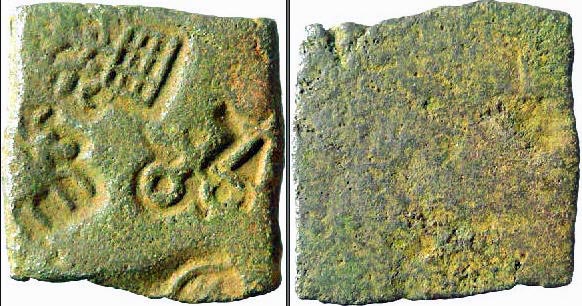
|
Eran, anonymous 3/8 AE karshapana, five punch 'bull type'
Weight: 3.52 gm., Dimensions: 17x17 mm.
Bull on the left, 'Ujjain symbol' in centre and Indradhvaja on the right;
railed tree on top and river at the bottom.
Blank reverse
Reference: Pieper 474 (plate coin)
|
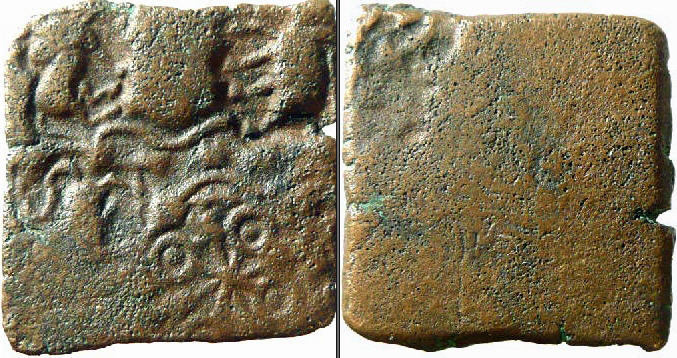
|
Eran, anonymous AE karshapana, five punch 'bull & elephant & lion type'
Weight: 7.47 gm., Dimensions: 20x20 mm.
River in centre; on top bull on the left and elepahnt on the right;
at the bottom lion on left and elaborate 'Ujjain symbol' on the right.
Blank reverse
Reference: Pieper 476 (plate coin)
|
 |
Mitchiner had published a specimen of this type (MACW 4617) but didn't mention
the important lion device which is a new symbol for the Eran coin series.
|
 |
 |
 |
Symbol Types
|
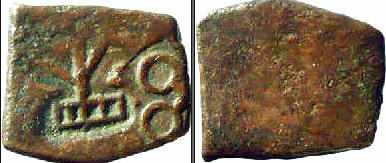
|
Eran, anonymous 1/8 AE karshapana, two punch 'symbol type'
Weight: 1.15 gm., Dimensions: 11x9 mm.
Railed tree on the left and Ujjain symbol on the right.
Blank reverse
Reference: Pieper 477 (plate coin)
|
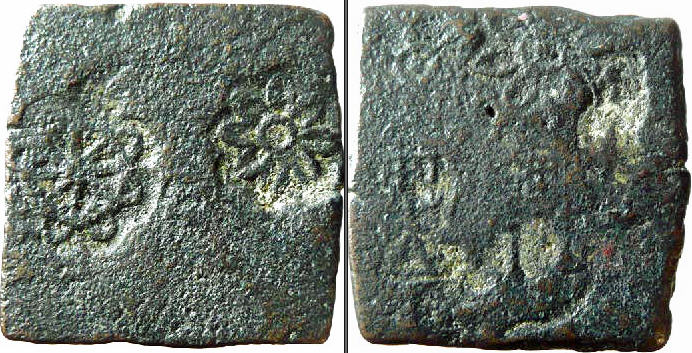
|
Eran, anonymous 3/4 AE karshapana, two punch 'symbol type'
Weight: 6.41 gm., Dimensions: 21x20 mm.
Obv.: Lotus flower and cakra.
Rev.: Worn traces of Eran coin undertype(elephant, river, railed Indradhvaja, lotus
flower, railed tree and six-armed symbol)
Reference: Pieper 478(plate coin)
|

|
Eran, anonymous 1/4 AE karshapana, three punch 'symbol type'
Weight: 2.07 gm., Dimensions: 14x14 mm.
Indradhvaja, 'Ujjain symbol' and six-armed symbol.
Blank reverse
Reference: Pieper 479 (plate coin)
|
 |
It is not certain whether this type originated in the Eran-Vidisha or in the Vidarbha region.
Recently Mitchiner listed specimens of this type with Vidarbha provenances. (MATEC coins 4737-4742).
|
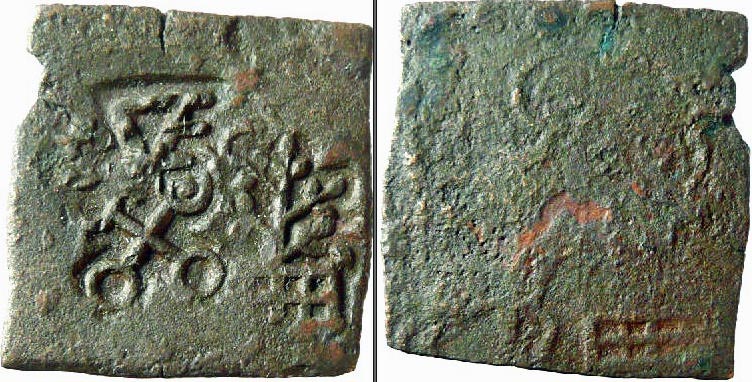
|
Eran, anonymous 3/4 AE karshapana, three punch 'symbol type'
Weight: 6.10 gm., Dimensions: 22x22 mm.
Obv.: Indradhvaja, railed tree and 'Ujjain symbol'.
Rev.: Worn traces of obverse design of Ujjain undertype depicting 'bull facing railed
Indradhvaja'.
Reference: BMC, pl.XVIII, no.16 / Pieper 481 (plate coin)
|

|
Eran, anonymous 1/2 AE karshapana, five punch 'symbol type'
Weight: 5.35 gm., Dimensions: 20x19 mm.
'Ujjain symbol', Indradhvaja, railed tree, river.
Blank reverse
Reference: Pieper 482 (plate coin)
|
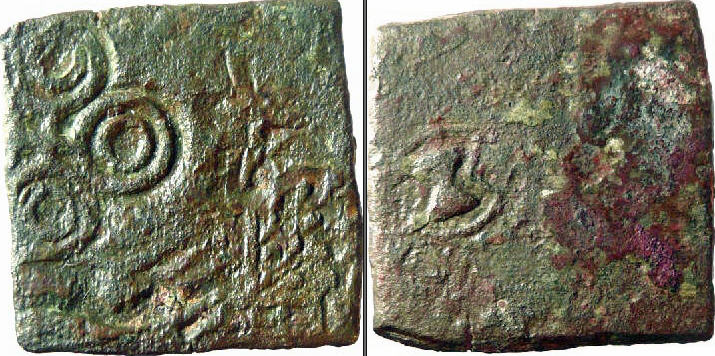
|
Eran, anonymous 1/2 AE karshapana, four punch 'symbol type'
Weight: 5.70 gm., Dimensions: 20x20 mm.
The same type as previous coin but a damaru-in-damaru-shaped-enclosure on
the reverse.
Reference: Pieper 483 (plate coin)
|
 |
The damaru revesre symbol might indicate that this type originates from Vidarbha. The Eran region is
close to Vidarbha and a typological link is certainly possible. There even might have been a common rule for some time in Damabhadra's reign
in the second part of the second century BCE. Mitchiner (MATEC p.1080) supports such a view.
|
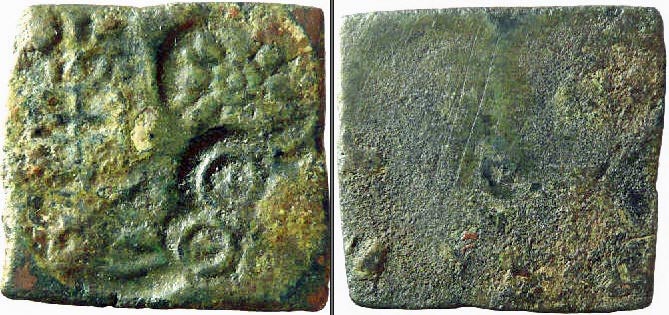
|
Eran, anonymous 1/2 AE karshapana, four punch 'symbol type'
Weight: 4.39 gm., Dimensions: 19x18 mm.
Railed tree on top left, flower on top right; at the bottom 'Ujjain symbol' on the right
and closed semicircle with two fish inside and two svastikas above on the left.
Blank reverse
Reference: BMC, pl. XVIII, no.12/ Pieper 484 (plate coin)
|

|
Eran, anonymous 1/2 AE karshapana, 'symbol type' countermark
Weight: 5.99 gm., Dimensions: 22x20 mm.
Obv.:Closed semicircle similar to that on previous coin but with 'Ujjain symbol' above
in one single punch (countermark)
Rev.: Worn Eran 'elephant & horse type' (elephant, horse, river,'Ujjain symbol)
Reference: -
|
 |
A number of different countermarks are known on copper coins from western and eastern
Malwa. Among them a standing human (Siva) type, railed tree, srivatsa flanked by taurines,
hill with plant on its top, taurine fixed in open railing, bull and probably some others. The c/m
on this coin is rarely found and is specific to the Eran-Vidisha region.
|
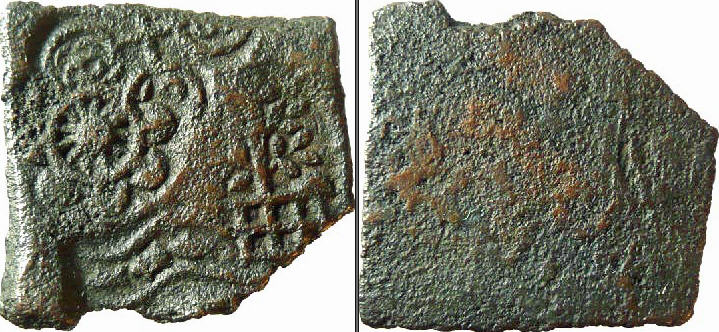
|
Eran, anonymous 1/2 AE karshapana, four punch 'symbol type'
Weight: 5.28 gm., Dimensions: 20x19 mm.
Elaborate 'Ujjain symbol' on top, below it a cakra on left and a railed tree on right;
river at the bottom on left.
Blank reverse
Reference: Pieper 485 (plate coin)
|

|
Eran, anonymous 1/2 AE karshapana, five punch 'symbol type'
Weight: 4.58 gm., Dimensions: 18x18 mm.
From left to right lotus-flower, railed tree and elaborate 'Ujjain symbol'; railed
Indradhvaja on top, river at the bottom.
Blank reverse
Reference: BMC. pl.XVIII, no.13 / Pieper 487 (plate coin)
|
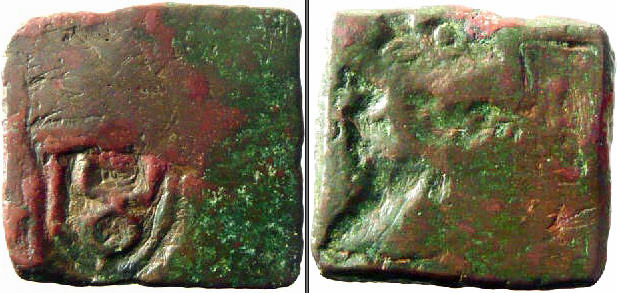
|
Eran, anonymous 1/2 AE karshapana, 'symbol type' countermark
Weight: 4.53 gm., Dimensions: 18x16 mm.
Taurine fixed in open railing is countermarked on the blank reverse of a worn Eran
undertype.The worn traces of the Eran undertype show 5 punches of which elephant, river and lotus
are identifiable.
Reference: Pieper 422 (plate coin)
|
 |
Like the closed semicircle the symbol which is applied as a countermark on this coin is also
quite typical for the Eran-Vidisha region. But while the closed semicircle is specific to that region,
the taurine fixed in an open railing appears also on some types beyond the Narmada river, i.e.in
Vidarbha regions.
|
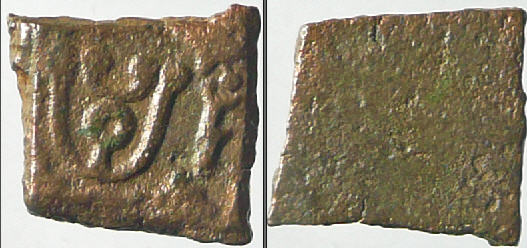
|
Vidarbha, anonymous uniface AE, single punch 'symbol type'
Weight: 0.68 gm., Dimensions: 9x7 mm.
Taurine fixed in an open railing, unidentified symbol on right
Blank reverse
Reference: Pieper 573
|
 |
The coin originates probably from Vidarbha together with another type of the same low weight class and the
same technique showing an 'Ujjain symbol' with a crescent attached to one of its orbs. This coin is listed here to demonstrate the common use of the peculiar taurine
fixed in an
open U-shaped railing.
|
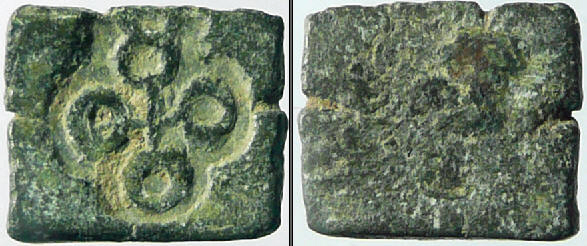
|
Vidarbha, anonymous uniface AE, single punch 'symbol type'
Weight: 0.69 gm., Dimensions: 10x8 mm.
'Ujjain symbol' with a crescent on one of its orbs
Blank reverse
Reference: Mitchiner (MATEC) 4770 / Pieper 574 (plate coin)
|
 |
The 'Ujjain symbol' with a crescent is of course well known as the dynastic symbol of the Satavahanas.
Its appearance on several local coin types in eastern Malwa and in the Vidarbha region suggests that these were the regions where the Satavahanas adopted
this symbol from local coin types. It appears less likely that the Satavahanas invented this symbol as a new creation, in which case all uninscribed coin types
with this symbol would have to be regarded as anonymous Satavahana issues.
|
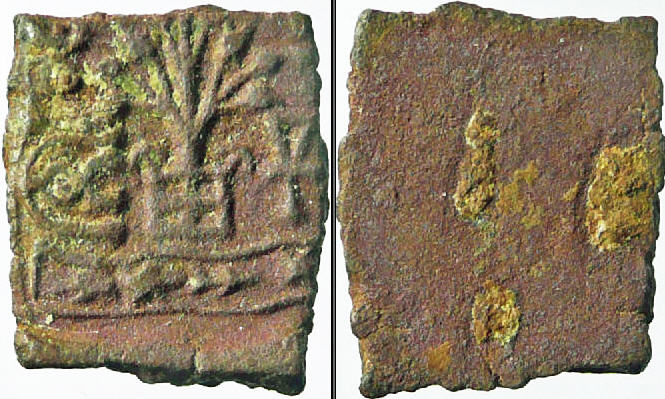
|
Vidarbha, anonymous uniface die-struck AE
Weight: 1.50gm., Dimensions: 14x12 mm.
Railed tree in centre; taurine fixed in open railing on the left with a nandipada on top left; on the
right is an Indradhvaja and at the bottom a river.
Blank reverse
Reference: Mitchiner (MATEC) 4775-4780
|
 |
Mitchiner describes Vidarbha provenances for all his specimens. Coins of the same type have however
also been reported from the Vidisha region of eastern Malwa. The taurine fixed in an open railing occurs not only on punchmarked coins of eastern Malwa but
also on die-struck coppers of that region as can be seen on coins from the Kurara series. Thus it would not be impossible that this is an anonymous type of
the Kurara series or at least typologically linked to that series. Its occurrence in Vidarbha might be explained by the close geographical relationship and by trade
exchange.
|
|
|